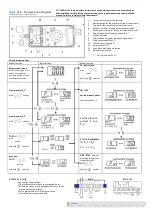
11
Set-point
Description
Available Options
Lower Limit
Lower Bound
Upper Bound
Upper
Limit
Units
Circuit Information
Circuit Number
Number of the circuit within the panel
Read-Only
1
72
None
Circuit Tag
Alpha-numeric Identifier
Read-only in Dashboard, User-
defined in Settings
50
Characters
Circuit Status
Percent On (Duty-Cycle); Enable Button
Disabled, Enabled, Enabled
Forced-On, Enabled Forced-Off
100
%
Temperature
High High Alarm/
High Temp Trip
1
High High Alarm: If Temperature Trip is disabled.
High Trip: If Temperature Trip is enabled
User-Defined
-200 (-328)
High Temperature
Alarm Set Point
Upper Limit
650
(1200)
°C (°F)
High Temp Alarm
2
High Temperature Alarm activates at and
above this set point
User-Defined
-200 (-328)
Max + 1
High High Alarm/
High Trip Set point
650
(1200)
°C (°F)
Max
Above Max heater duty cycle is 0%, i.e.
Heater is off
User-Defined
1
1
High Alarm set point -
Maintain set point - 1
650
(1200)
°C (°F)
Temperature
Real-time Temperature measurement
Read-only Measurement
-200 (-328)
650
(1200)
°C (°F)
Maintain
Set point at and below which heater duty
cycle is 100%
User-Defined
-200 (-328)
Low Alarm set
point + 1
Max - 1
650
(1200)
°C (°F)
Low Alarm
3
Low Temperature Alarm activates at and
below this set point
User-Defined
-200 (-328)
Lower Limit
Maintain
Temperature - 1
650
(1200)
°C (°F)
Notes:
1.
HIGH TEMP TRIP (HIGH HIGH TEMP) If HIGH TEMPERATURE TRIP is ON (OFF), this message will be displayed if the measured temperature rises above a value equal to the HIGH TEMPERATURE TRIP (HIGH) set-point.
2.
HIGH TEMP ALARM The measured temperature has risen above a value equal to the HIGH TEMPERATURE ALARM set-point but has not yet risen above a value equal to the HIGH TEMPERATURE TRIP/HIGH set-point.
3.
LOW TEMP ALARM The measured temperature has fallen below a value equal to the LOW TEMPERATURE ALARM set-point.
Heater Current
High High Alarm/
High Current Trip
4
High High Alarm: If Current Trip is disabled.
High Trip: If Current Trip is enabled
User-Defined
0
High Alarm
Upper Limit
100
A
High Current
Alarm
5
High Current Alarm activates at and above
this set point
User-Defined
0
Low Alarm + 1
High High Alarm/
High Trip
100
A
Low Current
Alarm
6
Low Current Alarm activates at and below
this set point
User-Defined
0
High Alarm set
point - 1
100
A
Notes:
4.
HIGH CURRENT TRIP (HIGH HIGH AMPS) If HIGH CURRENT TRIP is ON (OFF), this message will be displayed if the measured heater current is higher than the HIGH CURRENT TRIP (HIGH) set-point.
5.
HIGH CURRENT ALARM The measured heater current rise is higher than the HIGH CURRENT ALARM set-point but not above the HIGH CURRENT TRIP/HIGH.
6.
LOW CURRENT ALARM The measured heater current has fallen lower than the LOW CURRENT ALARM set-point.
Ground Current
High High Alarm/
High Leakage Trip
7
High High Alarm: If Ground Trip is disabled.
High Trip: If Ground Trip is enabled
User-Defined
20
High Alarm
Upper Limit
255
mA
High Leakage
Alarm
8
High Ground Fault Current Alarm activates
at and above this set point
User-Defined
20
Lower Limit
High High Alarm/
High Trip
255
mA
Notes:
7.
HIGH LEAKAGE TRIP (HIGH HIGH GROUND) If GROUND CURRENT TRIP is ON (OFF), this message will be displayed if the measured ground/earth leakage current rises above the GROUND CURRENT TRIP (HIGH) set-
point.
8.
HIGH LEAKAGE ALARM The measured ground/earth leakage current has risen above the GROUND CURRENT ALARM set-point but not above the GROUND CURRENT TRIP/ALARM2 set-point.
3.2.5: Dashboard/Circuit Details
The dashboard provides a comprehensive single circuit view. It includes the circuit
number, tag, pipeline number, or other status as well as real-time temperature,
heater current, ground leakage current and related alarm set points. This screen
can be reached by tapping a circuit in the Overview or the Circuit List. The limits
below define the lowest and highest possible values. (The bounds define the
constraints for valid values, e.g. maintain temperature should not be set below
the low temperature alarm.)
Circuit Alarms
In the event that the measured conditions of the heat trace circuit fall outside
the user-defined parameters, the Genesis will notify the user. When an alarm
condition first occurs, the common alarm digital output will annunciate and a
message will appear on the Circuit Screen to inform the user of the type of alarm
present. Pressing will acknowledge the alarm and deactivate the digital output.
Alarms will automatically clear when the alarm condition is no longer present.
Circuit Trips
In the event that the measured conditions of the heat trace circuit go beyond the
TRIP settings of the circuit, the circuit will trip, i.e. turn off. When a circuit trips,
the circuit will be deactivated and a corresponding message will be displayed.
(A TRIP event is different from an ALARM event in that the heat trace circuit is
deactivated and will remain deactivated until the circuit is manually reset by the
user.)












































